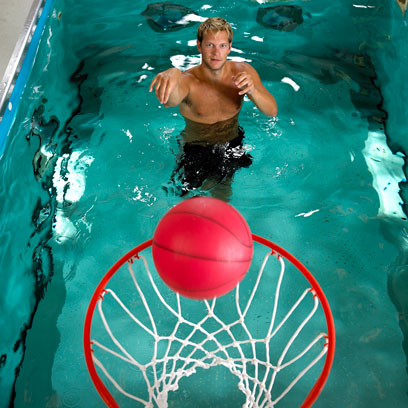How to Get the Most Out of Your Aquatic Exercise
There are so many benefits to taking your workouts underwater: increased strength, less perceived effort, decreased risk of injury and improved blood pressure, to name a few. But, as is true with any workout, there are good things to do in the water and even better ways to make your aquatic exercise productive. These principles are true for a professional athlete, someone starting a wellness program and anyone in between.
Getting The Most Out Of Aquatic Exercise
Don’t forget to stay hydrated
When you’re chest-deep in water, it’s easy to forget that it’s still extremely important to drink water! Because the perceived effort in water is less than on land, it’s easy to misjudge how hard one is working so staying hydrated is important. Keep a water bottle near the edge of the exercise pool and be sure to schedule water breaks, since the visual cue of sweating doesn’t exist underwater.
Warm up/cool down and stretch
Going for a run in the water can feel easy compared to a run on land. Thanks to the hydrostatic pressure of water, lactic acid is consistently pushed through the bloodstream resulting in reduced soreness after a workout. Even though your muscles feel less sore, they are still working just as hard or harder than on land. It is important to stretch before and after any exercise. If it’s available, underwater massage is a great way to continue to flush out any lactic acid and loosen tight muscles afterward.
Keep underwater gait patterns similar to land patterns
The viscosity of water creates drag on limbs that are moving through the water. When walking or running underwater it is important to avoid changing your stride length and pattern. This may require an exaggeration of movements to keep them similar. This extra effort underwater helps to build leg strength and improve balance. If possible, use a powered underwater treadmill which will help to keep your gait patterns on target. If an underwater treadmill is not available, be sure to keep your walking and running movements as steady and straight forward as possible, while keeping your head upright and maintaining normal arm swings.
Think outside the pool
Just because a workout may be conducted in the pool, doesn’t mean it has to be limited. Swimming, aqua-aerobics and underwater running are great ways to get cardiovascular benefits, but it does not have to end there. A little creativity can make an underwater workout specific to a person’s daily activities. For athletes, grab the ball of your choosing and get it in the water. Footballs, basketballs and soccer balls can be used to conduct sport-specific training in order to maintain important skills such as cutting, throwing mid-stride and catching while turning. Golf clubs and baseball bats can go in the water for added shoulder work, as the resistance of the water works to improve strength. For those just looking to keep up with their daily activities, items such as laundry baskets can be dunked in the water to work on balance and strength.
Grab a friend with similar goals
Having a companion or two for exercise is always an effective tool for keeping up with your goals. They can help motivate and push you, while also giving you someone with whom to share struggles and victories. A great way to do this with minimal space and resources is to create a little circuit training routine. Different stations can be made to keep workouts fun and all-encompassing. For instance, in a compact pool, such a HydroWorx 500 Series, you can have one person doing step-ups on the stairs, one person doing chest-presses with HydroTone bells on the platform and one person running intervals on the treadmill. This ensures you hit all aspects of training in one workout.
Don’t forget about the land
Since aquatic training can make you feel less sore and exhausted than land workouts, it’s tempting (especially for those just starting a workout routine) to keep to the water for exercise. Although this is a great way to get fit, in order to see greater gains from your water exercise, you should be sure to add land training to your weekly routine. It has been shown that aquatic exercise combined with resistance training can increase muscle mass more than aquatic exercise alone or even land exercise combined with resistance training.
To see more underwater exercise ideas, check out our video library>>



Hello water enthousiast,
I am a physical therapist who is expanding his territory into the world of aquatic exercise, fitness, therapy and rehabilitation. I am researching my options for certifications through AEA and ATRI. I am also checking out the equipment that is used in water, looking to buy and try out. I am familiar with a few things already (Aqua Jogger, AquaStrength, AquaLogix, Aqua Gear, Aqua Fitness, Kiefer, Speedo), but I am always looking to expand my horizons. I noticed a “new” product on the market for water aerobics, exercise and rehab, called the Aqua-Ohm. It looks very different than anything else out there. Does anyone have any experience with this particular piece of equipment? I looks versatile and fun….. Any thoughts??
Thanks!! Marco.
We don’t know of anyone who has used that product yet, but it looks fun! We always encourage using new and different products to keep the water engaging for patients and athletes. If you try it out, let us know what you think.
How many days/time should you do resistance training a week